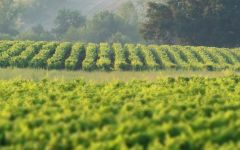Domaine de Bernier Chardonnay 2020
-
Tasting
Panel



Product Details
Your Rating
Somm Note
Winemaker Notes
This Chardonnay is produced by the Couillaud Family at the Château de la Ragotière, a few minutes from the Atlantic near the mouth of the Loire River, where the maritime climate is ideal for producing whites that are refreshing and bright. The Couillauds age most of this wine on its lees until bottling to add weight and texture. Saveur magazine wrote about a previous vintage: “This value-priced chardonnay tastes crisp and bright. It comes from the western Loire Valley, an unexpected place for this Burgundy grape variety, and is made in a fresh, unoaked style, nothing like the famed (and costly) Burgundy crus. Though unconventional, it’s delicious, with fruit flavors that echo pears and apples, and an enticing hint of minerality beneath the surface.”
Professional Ratings
-
Tasting Panel
Clean, fresh, and smooth with racy flavors; bright and charming; crisp and balanced with a long finish.





In 1978, just after purchasing Château de la Ragotière, the Couillaud brothers also purchased an estate on a beautiful hillside in the Loire Valley with a schist terroir. Part of the plot still needed to be planted, and Bernard Couillaud was curious about which varietals would do well in this area, where the two dominant varietals were Melon de Bourgogne and La Folle Blanche. After some research, the Chardonnay grape piqued his interest due to its unexplored potential in a maritime region. He launched the project and immediately set out for Chablis to research and learn more about Chardonnay. Planting started in the spring of 1987 and, over the course of three years, 42-acres were planted on the hillside plot.
Soon after the project began, Danny Haas of Vineyard Brands became interested and wished to taste the final product. In 1990, after having tasted Bernier Chardonnay amongst several other wines from the brothers, he was convinced of its potential and Bernier was introduced to the market.

One of the most popular and versatile white wine grapes, Chardonnay offers a wide range of flavors and styles depending on where it is grown and how it is made. While it tends to flourish in most environments, Chardonnay from its Burgundian homeland produces some of the most remarkable and longest lived examples. California produces both oaky, buttery styles and leaner, European-inspired wines. Somm Secret—The Burgundian subregion of Chablis, while typically using older oak barrels, produces a bright style similar to the unoaked style. Anyone who doesn't like oaky Chardonnay would likely enjoy Chablis.

Praised for its stately Renaissance-era chateaux, the picturesque Loire valley produces pleasant wines of just about every style. Just south of Paris, the appellation lies along the river of the same name and stretches from the Atlantic coast to the center of France.
The Loire can be divided into three main growing areas, from west to east: the Lower Loire, Middle Loire, and Upper/Central Loire. The Pay Nantais region of the Lower Loire—farthest west and closest to the Atlantic—has a maritime climate and focuses on the Melon de Bourgogne variety, which makes refreshing, crisp, aromatic whites.
The Middle Loire contains Anjou, Saumur and Touraine. In Anjou, Chenin Blanc produces some of, if not the most, outstanding dry and sweet wines with a sleek, mineral edge and characteristics of crisp apple, pear and honeysuckle. Cabernet Franc dominates red and rosé production here, supported often by Grolleau and Cabernet Sauvignon. Sparkling Crémant de Loire is a specialty of Saumur. Chenin Blanc and Cabernet Franc are common in Touraine as well, along with Sauvignon Blanc, Gamay and Malbec (known locally as Côt).
The Upper Loire, with a warm, continental climate, is Sauvignon Blanc country, home to the world-renowned appellations of Sancerre and Pouilly-Fumé. Pinot Noir and Gamay produce bright, easy-drinking red wines here.
